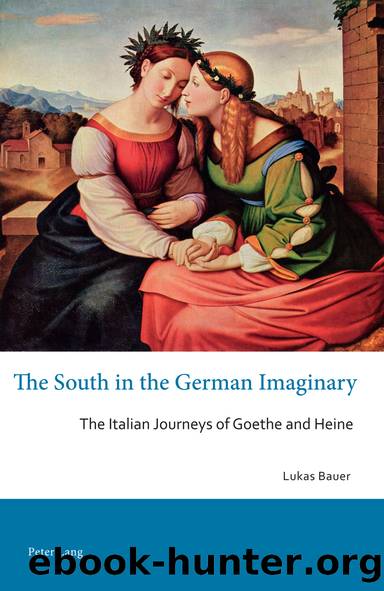The South in the German Imaginary by Bauer Lukas

Author:Bauer, Lukas
Language: eng
Format: epub
Publisher: Peter Lang AG
Published: 2015-05-22T00:00:00+00:00
1 The bucolic imagery associated with Arcadia dates back to Virgilâs pastoral poetry (Bucolica). With the revival of classical culture and art in the Renaissance, the topos of Arcadia was renewed and became lodged in the bloodstream of Western culture, becoming a popular motif in the eighteenth century. The motto Et in Arcadia Ego became popular, particularly through a series of paintings by Nicolas Poussin set in an idyllic landscape and that depicted a sarcophagus bearing the inscription, where the deceased was lamented by a group of shepherds. Originally it was understood to signify the omnipresence of death, even in Arcadia. However, by the eighteenth century this meaning had significantly changed, being generally regarded as signifying that the deceased had lived in Arcadia. In Herderâs poem Andenken an Neapel (1787), Italy becomes the embodiment of Arcadia and the motto becomes an evocation of Italy. It is this latter meaning, in which Goetheâs use of the motto should be understood (FA, vol. 15/2, 1168â70).
2 IR 179.
3 The Hurons were popularised in Europe in Voltaireâs novella Le Huron ou lâingénu (1767) (FA, vol. 15/2, 1306).
4 Pompeii was rediscovered in 1749.
Download
This site does not store any files on its server. We only index and link to content provided by other sites. Please contact the content providers to delete copyright contents if any and email us, we'll remove relevant links or contents immediately.
Twisted Games: A Forbidden Royal Bodyguard Romance by Ana Huang(3848)
Den of Vipers by K.A Knight(2639)
The Push by Ashley Audrain(2633)
Win by Harlan Coben(2607)
Echo by Seven Rue(2192)
Beautiful World, Where Are You: A Novel by Sally Rooney(2107)
Leave the World Behind by Rumaan Alam(2060)
Baby Bird by Seven Rue(2055)
Iron Widow by Xiran Jay Zhao(2055)
Midnight Mass by Sierra Simone(1962)
A Little Life: A Novel by Hanya Yanagihara(1936)
Undercover Threat by Sharon Dunn(1747)
Bridgertons 2.5: The Viscount Who Loved Me [Epilogue] by Julia Quinn(1735)
The Four Winds by Hannah Kristin(1725)
The Warrior's Princess Prize by Carol Townend(1599)
Sister Fidelma 07 - The Monk Who Vanished by Peter Tremayne(1589)
Snowflakes by Ruth Ware(1554)
Facing the Mountain by Daniel James Brown(1504)
Dark Deception by Rina Kent(1504)
